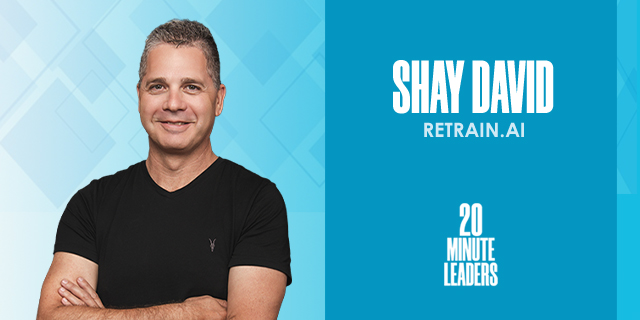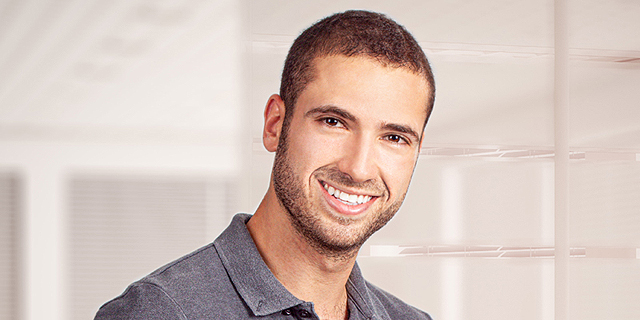
20-Minute Leaders
"Our job as entrepreneurs and as technologists is to make sure that the machines work for the people and not vice versa.”
Shay David, co-founder, chairman and CEO of Retrain.ai, tells Michael Matias that the company wants to use AI to help people achieve their potential
Click Here For More 20MinuteLeaders Tell me about yourself and your personality.
My background was always on the verge between scholarship and entrepreneurship. I've built a few big companies. The last big project was Kaltura, which just went public a few weeks ago. In terms of personality, I'm a builder. I like to build stuff.
My new baby is Retrain. We're building what I believe is going to be a very meaningful platform to solve the skills gap. It's all about putting technology to good use and letting machines do the hard work so that humans can fulfill their full potential.
What does it mean to call yourself a builder?
There's a lot of creativity in the process of taking an idea and making it real. It's about creating a vision. I think that that's probably true for every entrepreneur. You have to have some sense of "dissatisfaction" with the world. If you wake up and you're happy and everything's great, then everything continues as is. You have to see the problem where other people don't, but you also have to see an opportunity. For me, building stuff is identifying a change that is possible in the world and then articulating that vision and getting a team around it.
Give a brief history of how AI is shaping the way we think about jobs and people's roles.
We have to understand a tsunami is coming to the world of work. There are three major waves. One is the dramatic and dynamic shift in skills demand. A teacher used to have to write on a blackboard. Now, teachers need to use Zoom. To work in a warehouse, you needed to lift boxes. Now, you probably need to operate a robot. None of these things are happening overnight. But the adoption of automation, remote work, and digital transformation is changing what work is.
Wave number two is a very significant constriction in skills supply. There's not enough talent around the world. What people don't know, and this is also true for mid-skill and sometimes for low-skilled laborers, is there's a worldwide shortage of labor. How could we have huge unemployment and a consistent complaint that there's not enough talent? The answer is the skills gap.
Wave number three is that in most situations where there is a mismatch between demand and supply, there's two approaches to solve it: either you create a marketplace or you have a systems approach. The systems to manage HR, for the most part, are quite outdated.
These three waves create this tsunami, and the outcome is a dramatic limitation on a company's capability to grow and a dramatic mismatch in the talent pool where unemployment is the symptom. This is the problem that we aim to solve. We believe that in such a data-rich but information-poor area, AI, which is the capability to identify patterns in data, can serve a significant role in solving that skills gap.
How do you think through what solutions will enable this positive change?
We think that this is a data science problem. The first thing is to create a taxonomy and an ontology that could describe the world of jobs, people, and training pathways. The skills gap problem is a problem of understanding: What do employers actually need? What could the people do?
Now, we can start creating those matches. It could be a direct match. Maybe we can put somebody to work in an area where they didn't think they necessarily had the skills or the talent. But in other cases, it wouldn't be a direct match. We need to be able to map the training pathways to say, "You're at point A. You need to be at point B. Here's a pathway."
Think about creating the Google Maps or Waze of the labor market. We're creating the map of occupational opportunity. We're able to chart the courses where individuals need to be and want to be.
Are you effectively redefining job titles and descriptions? Part of the mismatch is the fact that over-generalized titles don't necessarily fit a specific person.
That's exactly right. There's a big trend in HR tech today to move away from job title/job description into a skills framework. There is a second move from the skills framework into career pathways. The changes that are required are so rapid that existing systems just can't keep up. The title might stay the same, but the actual content of that job is changing very rapidly.
We're helping organizations move into a skills framework. For example, we would come to a CEO and ask, "Why do you have a bank account?" "Because I have this resource. I want to secure it. I want to visualize it." But you also have another type of resource. You have skills. "How do you manage your skills portfolio?" "Oh, I do that with sticky notes on the fridge in the cafeteria."
If you're a large employer or an individual, managing your skills portfolio on sticky notes on the fridge is just not going to cut it. Think about our system as the part of that financial system to help you manage what is your most significant resource: your skills portfolio and skills wallet.
How do we get this to be a marketplace where we have most employers and future employees leveraging skill-based positions?
I think there are multiple avenues to market. There's a government aspect here and working with organizations around the world whose job it is to get people into jobs. Every single country around the world has employment services, a Department of Labor, Chambers of Commerce, and professional associations.
But I think it's probably an even bigger commercial opportunity to work with employers. The objective is not only to help people get back into the job market, but to actually work with employers that are undergoing rapid transformation. When we talk with business leaders, they do not have an aspiration to just fire everybody and start fresh. They're very sorry for every person that they need to let go. But sometimes they just don't know how to keep the talent.
This is where the AI comes in. What we've developed is a system that understands any language. It could read job descriptions, CVs, LinkedIn profiles, and want ads. We've trained the AI models on language from the labor market so that it can start creating those matches and start helping the organizations understand their own needs and how they solve the skills gap by either being able to retrain internal talent or prioritize external hiring.
Back in elementary or middle school, what really fascinated you?
I did part of my elementary school in the Valley. I got exposed to those early days of computing. The first personal computer that I had was a public TI-99 computer in Palo Alto at a public library where you would get one hour a week. What inspired me then was the capacity of machines to get the hard work done for people so people could do the more interesting stuff.
Where do you derive your day-to-day inspiration from?
What inspires me is the capacity to put technology to good use in the hands of a lot of people that might not otherwise benefit and to make technology consumable by large enterprises and by individuals.
What are a few words that represent Shay David? I'll start with "builder.”
Getting things done. At the higher level, mind, body, and spirit. It's about building things in the real world that solve real problems and really cater to the human spirit.
Michael Matias, Forbes 30 Under 30, is the author of Age is Only an Int: Lessons I Learned as a Young Entrepreneur. He studies Artificial Intelligence at Stanford University, while working as a software engineer at Hippo Insurance and as a Senior Associate at J-Ventures. Matias previously served as an officer in the 8200 unit. 20MinuteLeaders is a tech entrepreneurship interview series featuring one-on-one interviews with fascinating founders, innovators and thought leaders sharing their journeys and experiences.Contributing editors: Michael Matias, Megan Ryan
